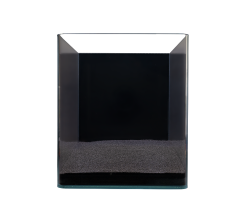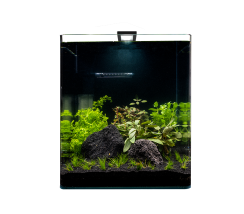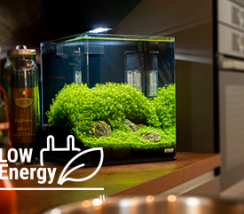The nano aquarium
With its innovative Nano Cubes, Dennerle was the initiator and pioneer of modern nano aquaristics, which experienced its boom in 2008 and is still very much in vogue.
Even in the past there were small aquaria, but it was difficult to find suitable aquarium technology. With our Nano line this has changed! For the cubes from 10 to 60 liters and the nano tanks from 35 to 70 liters, there are not only specially designed filters, but also the appropriate lighting, aquarium heaters, decorations and other accessories in nano format.
Nano aquaria are small and easy to care for – the maintenance work can be done quickly and easily. It is particularly important to feed only as much as is eaten immediately and to carry out a partial water change of 30 – 50 % every week.
There is always a place for a cube or a tank – you don’t need an aquarium cabinet for it. These tiny creatures also make a cool living lifestyle and decorative element.
Nano Cubes and Nano Tanks are ideal for keeping dwarf shrimp – robust, colorful Neocaridina species or the somewhat more demanding bee shrimp, tiger shrimp and co. from the genus Caridina.
For cubes and tanks from 30 liters even fish are possible – but of course not just any! Small tanks are perfect for a single fighting fish (Betta splendens), for example, or for small schooling fish such as mosquito danios (Boraras brigittae), other dwarf danios of the genus Boraras, for sparkling tetras (Hyphessobrycon amandae) or for dwarf carps (Heterandria formosa). Dwarf bluefish (Dario dario) also fit well in such an aquarium. Of course, the selection of fish is larger for the nano aquariums from 55 liters volume.
If you want to keep fish in a nano aquarium, you should limit yourself to 1 – 2 species and pay attention to suitable group sizes. The association with shrimps is usually unproblematic with small fish.
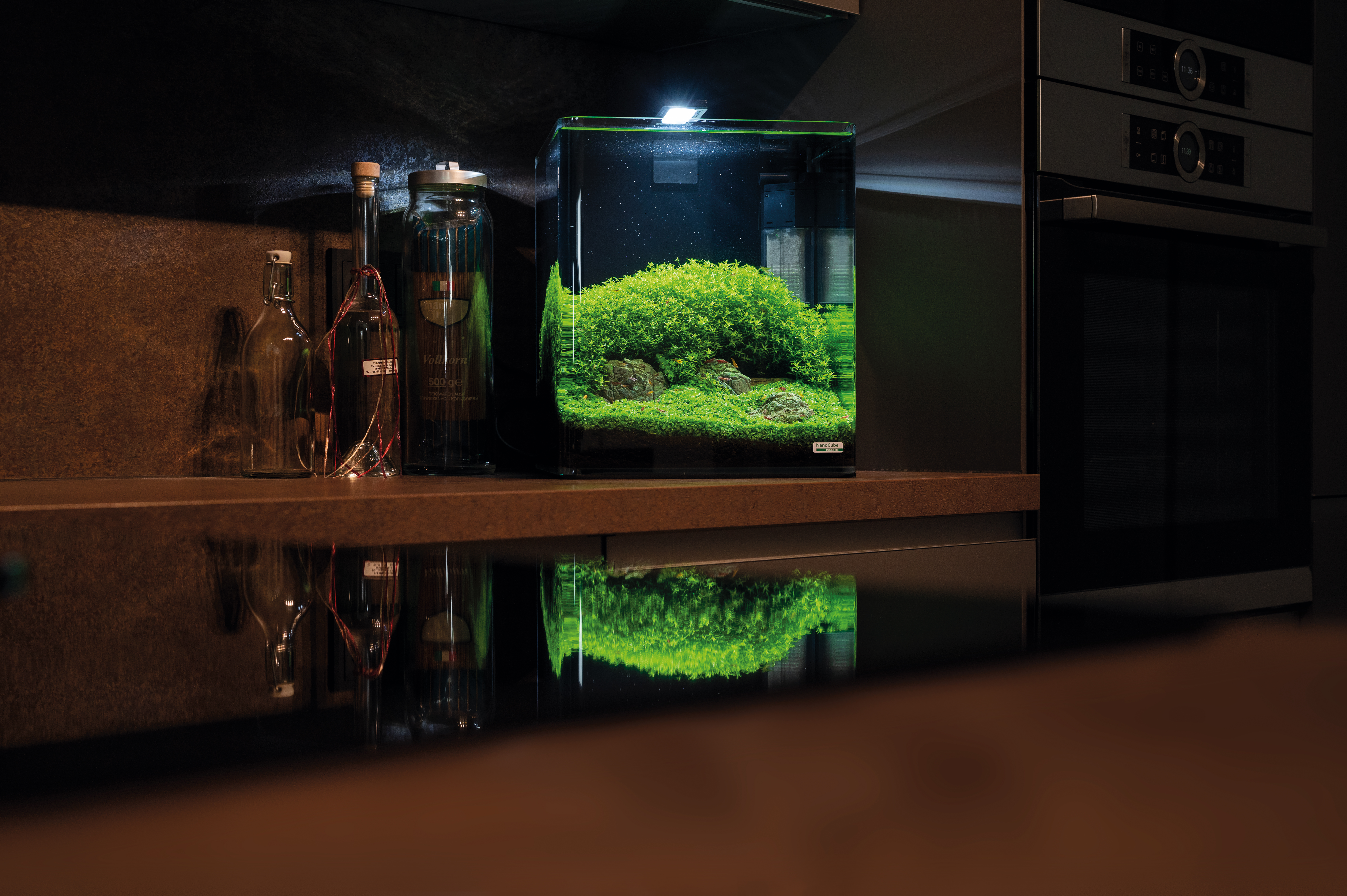
The Society Aquarium
A true classic and probably the most popular type of aquarium is the community aquarium, typically ranging from 54 to 200 liters in volume – though there are no upper limits here.
Colorful fish, shrimp, small crayfish and snails cavorting in the lush green jungle of the underwater landscape – the sight of them fascinates and makes the stress of everyday life drip away immediately. A well-designed community aquarium is a piece of nature for your home!
The diverse life forms of the aquarium inhabitants are great to observe, their exciting and interesting behaviors simply enchant. Here you can really forget about time and sink into the green underwater world.
Smaller tanks can stand on a stable piece of furniture or a table, for larger aquariums from 100 liters we recommend a suitable and stable base cabinet especially for aquariums – not only for safety reasons. Well-designed aquarium base cabinets offer you various practical options for storing aquarium technology, accessories, food and fertilizer in an easily accessible manner. Cables and hoses can be inconspicuously routed and thus somewhat hidden.
A community aquarium is planted with green and colored aquarium plants and is furnished with roots, stones and other aquarium decorations. It provides space for the care of plants and animals from different parts of the world and biotopes that have similar environmental requirements.
Various colorful fish swim here and ideally all water zones – from the bottom to the upper water layer – are occupied by appropriate species. Invertebrates such as shrimps or snails are also often part of the aquarium community.
Especially for a community aquarium it is important that plants and fish are in biological balance. With our products, feeds, plant fertilizers, tools and aids that are specially tailored to the needs of your aquarium inhabitants, we actively support you in this.
When selecting fish and invertebrates, please make sure that your aquarium animals match in terms of requirements, behavior and size. For example, rather reserved fish should not be kept with very lively species, and pronounced food specialists also have a rather difficult time together with all-rounders. The community aquarium will be perfect if your stocking and the planting are in balance.
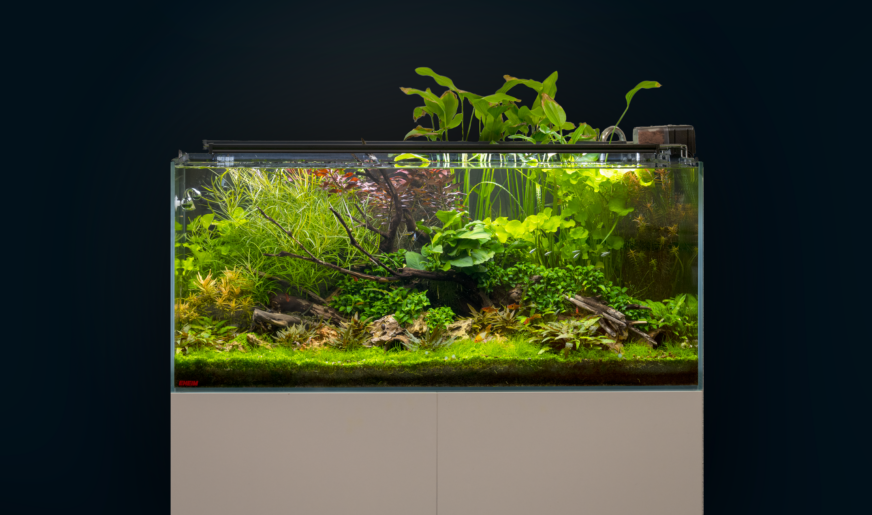
The children’s aquarium
An aquarium in the children’s room is really recommendable from an educational point of view. Here children can get to know a piece of nature up close and observe and understand simple relationships. They enjoy the pretty colorful fish and take their first steps towards more responsibility.
Very often, such a children’s aquarium has a capacity of 54 liters and an edge length of 60 cm – small enough to fit in the children’s room, but large enough for easy-to-care-for plants and fish. Classics for this type of aquarium are the colorful and quite robust guppies or platies.
There is a little researcher in every child. Along the way, children who care for an aquarium gain a valuable understanding of biological processes. They learn how to build a functioning ecosystem on a small scale, they gain important insights and discover fascinating connections.
In the aquarium, kids observe the interactions in nature up close and learn to take responsibility for living creatures. Nothing makes a child prouder than when the fish they care for feel good and, ideally, even have babies. Children are always enthusiastic about this!
Depending on how old your kids are, you may want to help them out more or less with aquarium maintenance and feeding the fish. Setting up the aquarium together is a great parent-child activity and a lot of fun.
Basically, you should select rather robust animals and plants for the children’s paradise in the glass. It can also be useful to “steer” a little when setting up the aquarium. For a short time, kitschy aquarium decorations may seem fascinating, but people quickly get tired of colorful plastic. Many children like a beautiful natural biotope with great plants and colorful fish even better.
And if it should be a colorful piece of aquarium decoration: Make sure that they are food-safe and water-neutral, so that no undesirable substances get into the water.
The Dutch plant aquarium
The Dutch plant aquarium, or Holland aquarium for short, marks the beginning of modern, sophisticated plant aquaristics. It did a lot of pioneering work in terms of lighting, CO2 supply and plant fertilization. The “Dutch Style” became popular in the 60s and 70s and still enjoys great popularity today. As early as 1956, the Dutch Society of Aquarists (NBAT) laid down the guidelines for this aquarium style.
Dutch style is all about successfully keeping aquatic plants and presenting them in the most aesthetically pleasing way possible. A Dutch aquarium typically holds 100 liters or more. There is virtually no aquarium decoration in the form of roots, stones or other fixtures – exceptions prove the rule.
Unlike other types of aquaria, the design of a Holland aquarium is not predominantly based on natural models. The planting is kept rather formal and appears garden or park-like. Mostly you work in the Dutch plant aquarium with plant streets, the so-called Leiden streets. For this you use similar aquarium plants in a ribbon-like diagonal arrangement.
You select aquatic plants for these plant bands based on size, color, and leaf shape, not necessarily on their origin or biotope. Neighboring species usually contrast strongly visually, but the overall layout should be harmonious. It plays with structures, leaf shapes and plant colors that make the plant groups stand out from each other and make the layout interesting. You let the plant streets increase in size towards the back to achieve a depth effect. It is important to keep the plants in good shape by trimming them regularly so that the plant streets remain recognizable.
Fish play only a subordinate role in the Dutch plant aquarium. In principle, you choose the fish stock less colorfully mixed than in a classic community aquarium, but rather rely on a larger shoal of a single fish species. South American tetras or small Asian danios are well suited. Invertebrates such as shrimp keep algae and plaque in check.
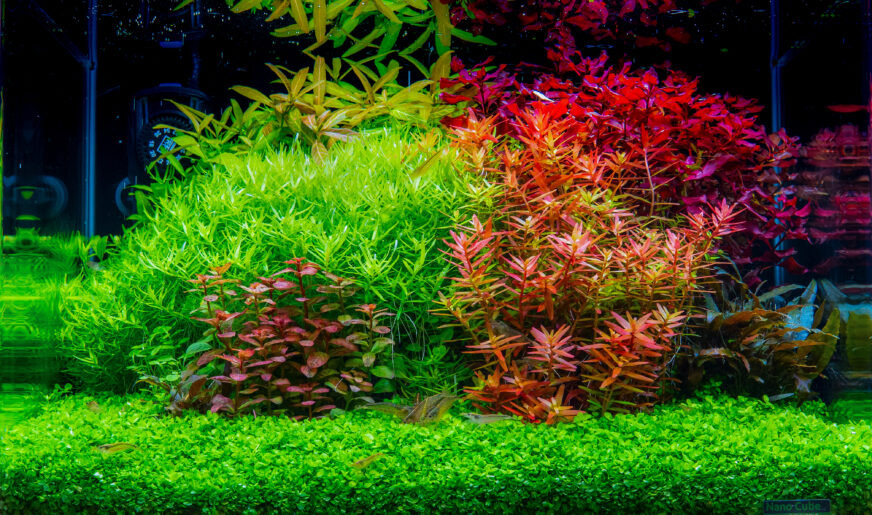
The aquascaping aquarium
Aquascaping is modern and current, an extremely imaginative way to design an aquarium layout. Above all, the high level of detail inspires viewers. A scape is a total art value of aquarium decoration, aquatic plants, the stocking and the technical accessories. All aquarium sizes are possible, from nano tanks to giant aquaria.
Design and appearance are in the foreground: in aquarium accessories, too, value is placed on a pleasing shape and high-quality materials. The pioneer of this style was the Japanese Takashi Amano with his natural aquaria. International and national aquascaping competitions enjoy great popularity.
For this style, you orientate yourself very strongly on natural models for the layout and aquarium design: Sections from a biotope, but also natural landscapes. Often a meadow, coastal or mountain landscape is reproduced in the aquarium. Your own observations in nature or photos of impressive landscapes can serve as a source of inspiration.
The “hardscape”, i.e. stones, roots and other natural material, gives the layout its basic structure. Mostly, the principle of the golden section is used for the layout, a spatial division in the ratio of approx. 2:3, which makes the scape look more natural.
Some aquascapes stay only a short while until everything is nicely grown in – about three months. Then “the” photo, the so-called final shot, is taken and, if necessary, the next scape is set up in the tank. Other aquascapers, on the other hand, let their works of art stand for a longer period of time and enjoy the changes that become visible in the longer term.
Aquascapes require some attention – as a rule, they are operated with plenty of light, supplied with CO2 and fertilized accordingly to achieve optimal plant growth. By cutting and trimming the plants, the aim is to achieve the most compact, bushy growth possible. For this purpose, there are special “tools”, that is, special scissors and tweezers that facilitate this work.
In aquascaping, there is now also a trend towards easier-to-maintain scapes with more frugal plants and less complex technology, which makes it easier for beginners in this fascinating style of aquatics and is also somewhat less expensive.
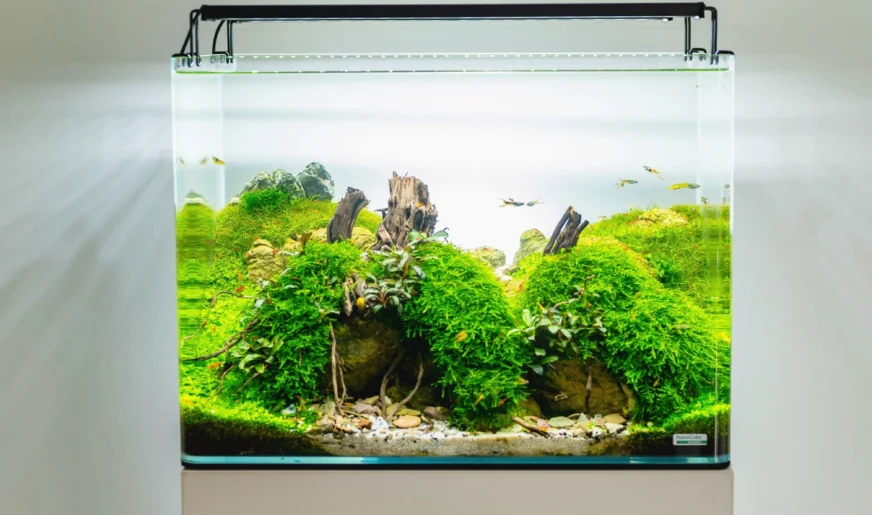
The biotope aquarium
A biotope aquarium is based – as the name suggests – on a natural biotope. Most often it finds a place in a tank of 54 to 200 liters, but the size is open upwards.
The biotope aquarium should reflect a section of nature that is as true to the original as possible. You should therefore recreate the natural biotope as faithfully as possible. In this aquarium style, only plants and fish or invertebrates that really come from the respective biotope are used. How narrowly you define a biotope is up to you.
Rather general would be an aquarium with the theme “South America”, “Central Africa” or “Southeast Asia”, already narrower is an Amazon biotope. It becomes more specific if you take a small stream, a spring, a lake or a riverbank as a model and go into detail here. The latter approach is useful if you have access to local forms of certain fish or water plants.
It is important for the biotope aquarium that you not only select the plants, aquarium decorations and the fish and invertebrate stock to match the theme, but also try to create water conditions similar to those in the original biotope. By adding humic substances, alder cones or sea almond leaves, for example, you can create near-natural black water as in the Rio Negro. Soft water can be produced well with the help of an osmosis system. With an appropriate hardening salt, it can be easily and simply remineralized and adjusted to the desired values.
Such a layout is especially beautiful if you orientate yourself on underwater pictures from nature. You can deviate somewhat from the classic aquarium decoration of roots and stones – if branches or tree roots hang in the water in the natural biotope, you can recreate this with alder branches, for example.
The Betta-aquarium
Siamese fighting fish (Betta splendens) are magnificent aquarium fish with interesting fin shapes and amazing colors and patterns. Especially for high breeders with long fins, it is ideal if you keep them in smaller aquaria. Fighting fish, with their labyrinth organ, breathe atmospheric air at the surface of the water and especially large finned fish find it easier to get around in a less tall tank. A good choice for keeping fighting fish is for example our Nano Tank 35.
Betta splendens are smart fish that interact with their keeper and they also show their interesting behavior in the aquarium. You can use a small pocket mirror to encourage your fighting fish to spread its fins. This is a natural impersonation behavior that he would also show in nature when a conspecific comes into his field of vision. Performed occasionally, this acts, to put it casually, like a kind of gymnastics for the fish.
Because male Siamese fighting fish can become very aggressive within the species, they should be kept individually. Depending on the character of the fighting fish, socialization with shrimp and snails as scavengers and algae eaters is usually possible. However, from time to time there are also fighting fish that eat young shrimp or even adult shrimp or nibble on snails.
The Siamese fighting fish likes it a little warmer, the water temperature should be 25 – 27 °C. It also needs dense planting in its aquarium. Also in nature it lives in the weedy margins of calm waters and sometimes in rice fields. According to their natural biotope, fighting fish do not like strong currents in the aquarium either.
Fighting fish love to chill on large plant leaves just below the water surface. So you should not only plant the aquarium for your Betta with fine-feathered plants, but also include aquarium plants with somewhat larger leaves and let them grow up to the surface. When setting up the aquarium, make sure that the fish cannot get trapped under the aquarium decorations or behind the filter. Bettas are incredibly curious and will squeeze into any nook and cranny if they suspect something interesting is there. Narrow crevices can easily be closed with some filter foam.
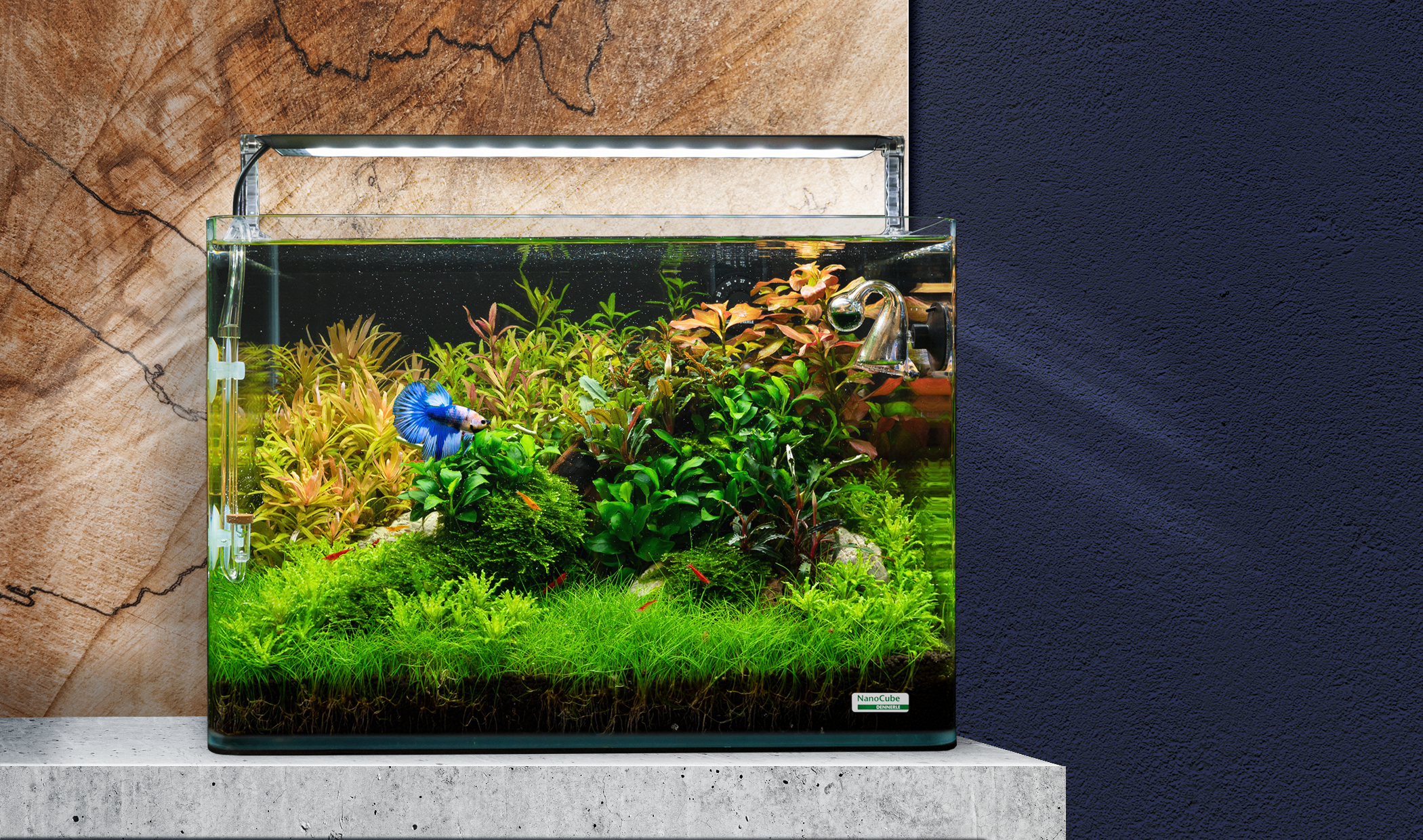
The discus aquarium
The beautiful discus from the Amazon region belongs to the South American cichlids and is quite rightly considered the king of aquarium fish. In the aquaristics there are beside the red-blue wild form also some very attractive breeding forms. The laterally strongly flattened fish have the form of a disc, which is called “discus” in Latin. They move slowly and majestically in the aquarium.
Discus are very sociable fish, they like to live and interact in a group of conspecifics. Keeping them alone would not be appropriate for the species. However, they can become aggressive and stressed when moving quickly, and although socialization with slow swimming fish is possible, keeping Discus in a species aquarium with an emphasis on fish keeping is still the best option. In addition, discus are decidedly slow eaters. Therefore, a combination with fast, swimming fish is not advisable.
A group of 4 – 6 Discus can already be kept in an aquarium with a volume of 200 liters or more, whereby especially the adult fish with a length of 15 cm definitely appreciate more space. For a full-grown Discus one calculates therefore approx. 50 – 100 liters. Too little space can lead to individual fish being suppressed in the group, which can stress them so much that they become more susceptible to disease.
Thistles need it very warm, and there are few plants that can tolerate the 28 – 30 °C water temperature they prefer. In addition, the king of aquarium fishes not only needs warm water, but also very clean, soft and slightly acidic water – which further limits plant selection. Above all, the nitrate value should be below 10 mg/L for keeping the sensitive fish.
However, it is not impossible to plant the aquarium: various ferns, tiger lotus, Amazon sword plants and cryptocorynes cope well with the conditions. However, you should not plant the discus aquarium too densely, so that the animals can still fight within species. Discus also like to eat food from the bottom.
You need a large volume biofilter but little flow.
The Malawi / Tanganyika aquarium
A classic biotope aquarium is a tank for Malawi or Tanganyika cichlids. The fish from the African Lake Tanganyika or Lake Malawi are often very colorful and almost somewhat reminiscent of colorful inhabitants of coral reefs. Many of these cichlids grow quite large. In addition, they are usually very active swimmers. There is always something going on in such an aquarium.
Depending on the size of the fish kept, tanks with a capacity of 100 liters or more are suitable. Basically, the larger the aquarium, the better it can be structured and the more swimming space the fish have.
The fish from the rift valley lakes in East Africa require very specific water values – the water in their home waters has a higher pH value and a very specific water hardness. In the aquarium they show themselves to be relatively adaptable, but the water should also be medium hard to rather hard here according to the biotope.
Because many of these cichlids not only eat algae, but also nibble on plants, the focus in a Malawi or Tanganyika aquarium is definitely on the fish. Following the example of natural habitats, it is best to use stone biotopes in the aquarium, which can be imaginatively staged. Crevices, caves, even overhangs can be created with a little skill from aquarium stones and make the layout of the Malawi or Tanganyika aquarium interesting.
Planting is also hardly possible for other reasons: only a few plant species can cope with the special water values and the higher pH value. In addition, many fish species from Lake Tanganyika or Lake Malawi burrow heavily and would simply dig up the planting. If you want to have some greenery in the aquarium, hard-leaved species like Anubias are a good choice, which are not planted into the substrate, but are attached to the stones as a perch.
Shallow Tanks
The latest trend in aquatics translates roughly as “shallow aquaria.” Shallow tanks usually hold around 30 to 100 liters and are not particularly high in relation to their footprint.
In these shallow, but therefore quite deep aquaria, you can create your own very interesting look with the appropriate equipment. Often in the Shallow Tank you leave a part of the decoration made of roots or stones sticking out of the water. This type of aquarium setup looks particularly natural – like a small section of a shoreline landscape or a stream with stones and pieces of driftwood.
The advantage of these basins: Because most aquarium plants are actually marsh plants that can grow both above and below water, they can grow out of the water and then even come into bloom. Often the underwater and above-water shapes of the leaves are quite different, which can make for interesting views in the Shallow Tank. You can also let mosses grow above the waterline.
For example, perched plants such as Bucephalandra or Anubias are beautiful on the border of water and land – this location corresponds exactly to how they like to grow in nature. You can also design the land part perfectly with moisture-loving land plants such as ferns or orchids. They thrive very well due to the high humidity.
Depending on the size of the water section in your Shallow Tank, you can keep shrimp and snails as algae eaters and cleanup creatures, or even have small fish live in it. If you want to prevent your snails from crawling out of the open tank, you can apply a fine film of Vaseline to the top edge. This will usually not be crawled over by the snails. If you want to keep fish in your Shallow Tank, be sure to choose fish species that will not jump out of the tank.

